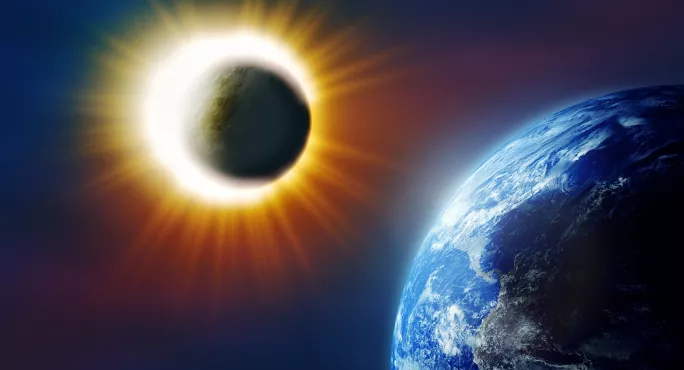A total eclipse for your class: how to make the most of Friday’s solar event

On Friday this week, people across Europe, North Africa and parts of the Middle East will be able to witness a partial solar eclipse. The far north of Europe and the Arctic, meanwhile, will see a total eclipse.
What is a solar eclipse?
A solar eclipse happens when the moon and the sun’s orbits cross, and the moon is briefly positioned directly between Earth and the sun. As a result, the moon temporarily blocks out some of the sun’s light: it can look as though someone has taken a bite out of the sun.
Europeans, depending on how far north they live, will see the moon cover between 30 and 98 per cent of the sun. The further north you live, the more of the sun will be obscured. All of England will witness a partial eclipse of more than 80 per cent.
Partial eclipses are relatively common, occurring in cycles called saros. During the 21st century, there will be 224 eclipses. The next big partial eclipse will be seen in the UK on 12 August 2026.
And what about a total eclipse?
A total eclipse happens when the moon appears to block out all of the sun, darkening the sky and leaving only a ring of light visible around its shadow. Tomorrow’s total eclipse will be visible in the Faroe Islands and Svalbard. In reality, this means it will be witnessed mostly by some sheep and a handful of polar bears. The official tourist board of the Faroe Islands has already tweeted a picture of some grazing sheep, with the caption: “Silence of the lambs. Everyone here at the Faroe Islands is waiting in patience for tomorrow.”
The total eclipse will last for two hours and 46 seconds. It will begin at around 9.10am, reach the Faroe Islands at 9.40am, and finish at 11.50am.
Total eclipses are much rarer than partial eclipses. The UK last saw one in 1999. The next will be in 2090. Reserve your seats now.
When can I see the eclipse?
The eclipse will begin in the west, so people living in western Africa and Europe will see it first. It will start at 7.41am, and the moon will be closest to the middle of the sun at 9.31am. By 10.41am, the eclipse will be over, and daylight restored. As it moves from west to east, it will not be visible to all people for the entire three-hour duration; in most regions, it will last for slightly more than an hour.
Turn around!
The most important thing to bear in mind is that one must never, ever look directly at the sun, even when it is covered by the moon. The sun’s intensity can cause permanent damage to the eyes. And, said a spokesman from the College of Optometrists, the risk is that, “As the eclipse is a relatively slow process, people might end up accidentally looking at the sun for minutes.”
In fact, schoolchildren from Oldway Primary School in Devon have been told that they would need to watch a filmed version of the eclipse in their classrooms, rather than going outside to see it. The headteacher feared that she would be unable to safely prevent all 700 children from looking at the sun.
There are, however, a couple of safe ways to watch the eclipse. One is by wearing a pair of eclipse glasses, specifically made to block dangerous wavelengths of light. Normal sunglasses are not a safe substitute. Alternatively, one can turn away from the sun and view it through a pinhole camera.
Questions
- Why is a solar eclipse seen as an important event?
- Can you explain why an eclipse is seen differently in other parts of the world?
- What is dangerous about looking at a solar eclipse and what can you do to stay safe?
- The next total solar eclipse viewable from the UK will be in 2090. Do you think the world we live in will be very different in 75 years’ time?
Resources
Presenting the eclipse
Use this slideshow as a starting point for explaining what happens during an eclipse and necessary safety precautions.
Solar eclipse video
Guidance and information for safely observing the partial solar eclipse on 20 March.
Solar and lunar eclipses
A differentiated worksheet on the science behind the different types of eclipse.
Solar eclipse worksheet
Get pupils investigating as they find the answers to these four questions using internet research.
Keep reading for just £1 per month
You've reached your limit of free articles this month. Subscribe for £1 per month for three months and get:
- Unlimited access to all Tes magazine content
- Exclusive subscriber-only stories
- Award-winning email newsletters



